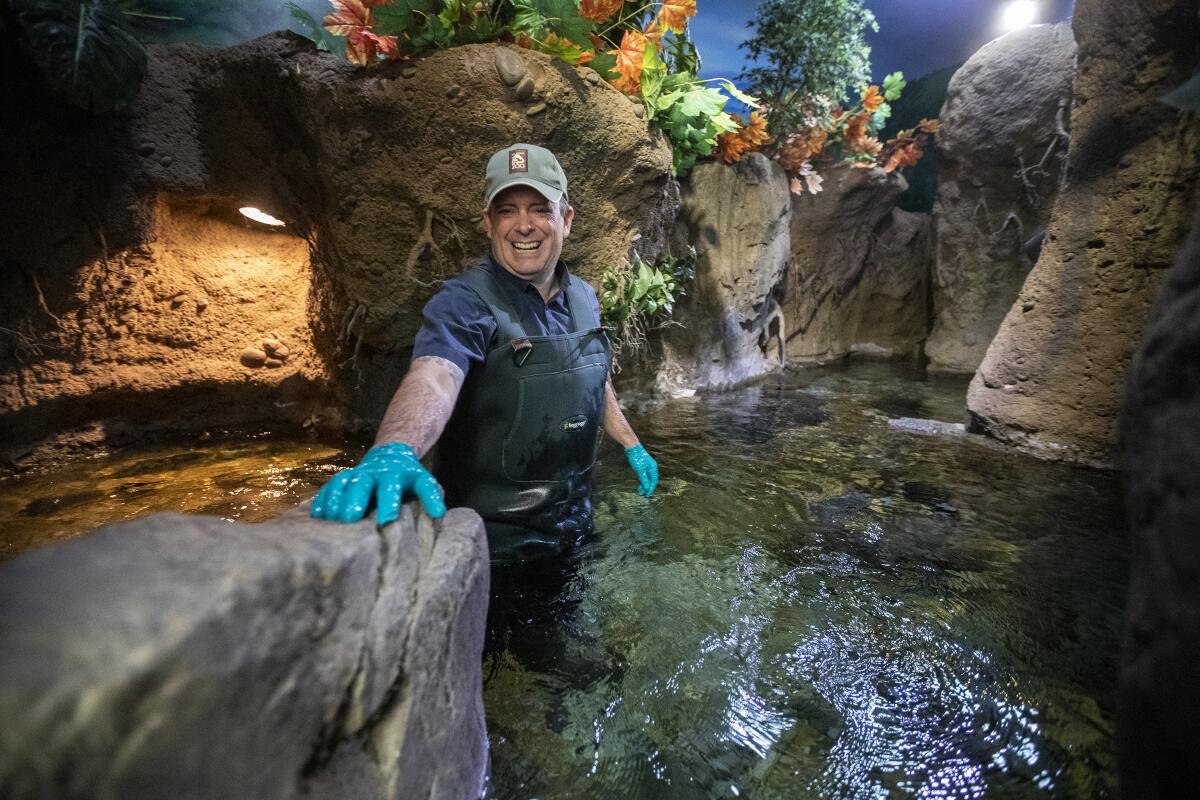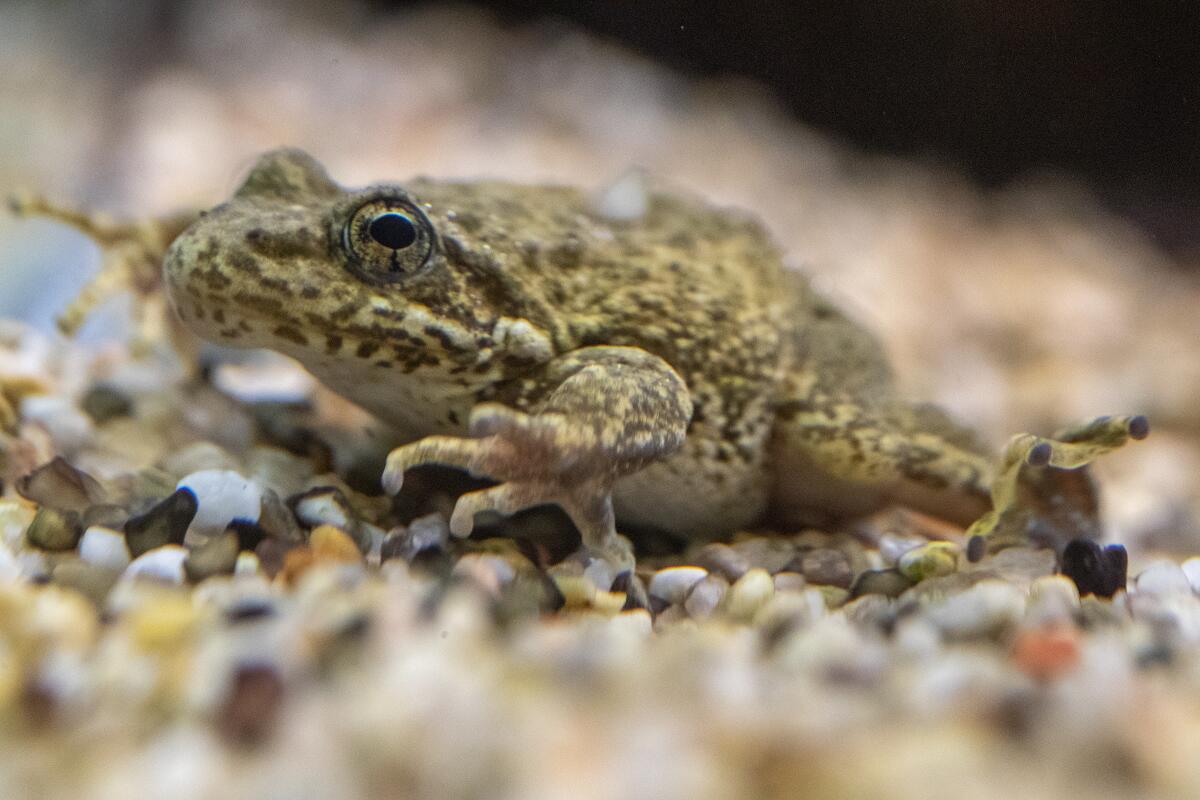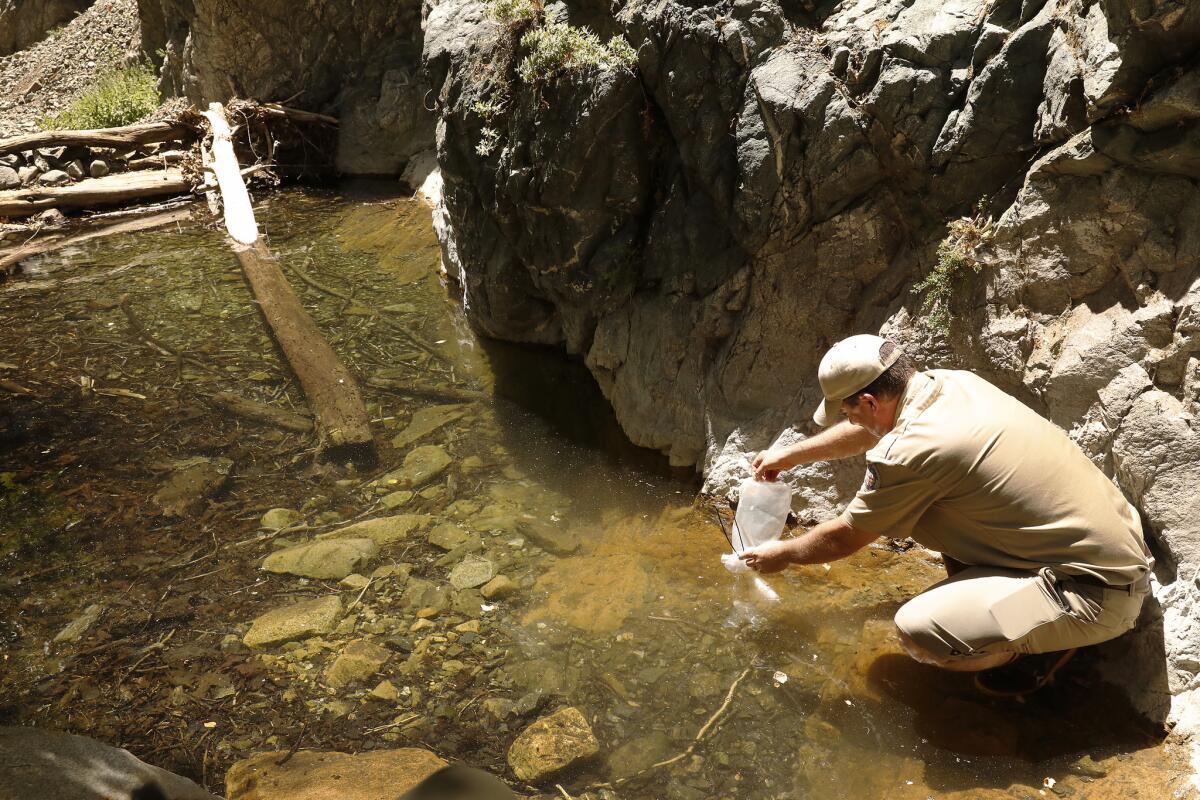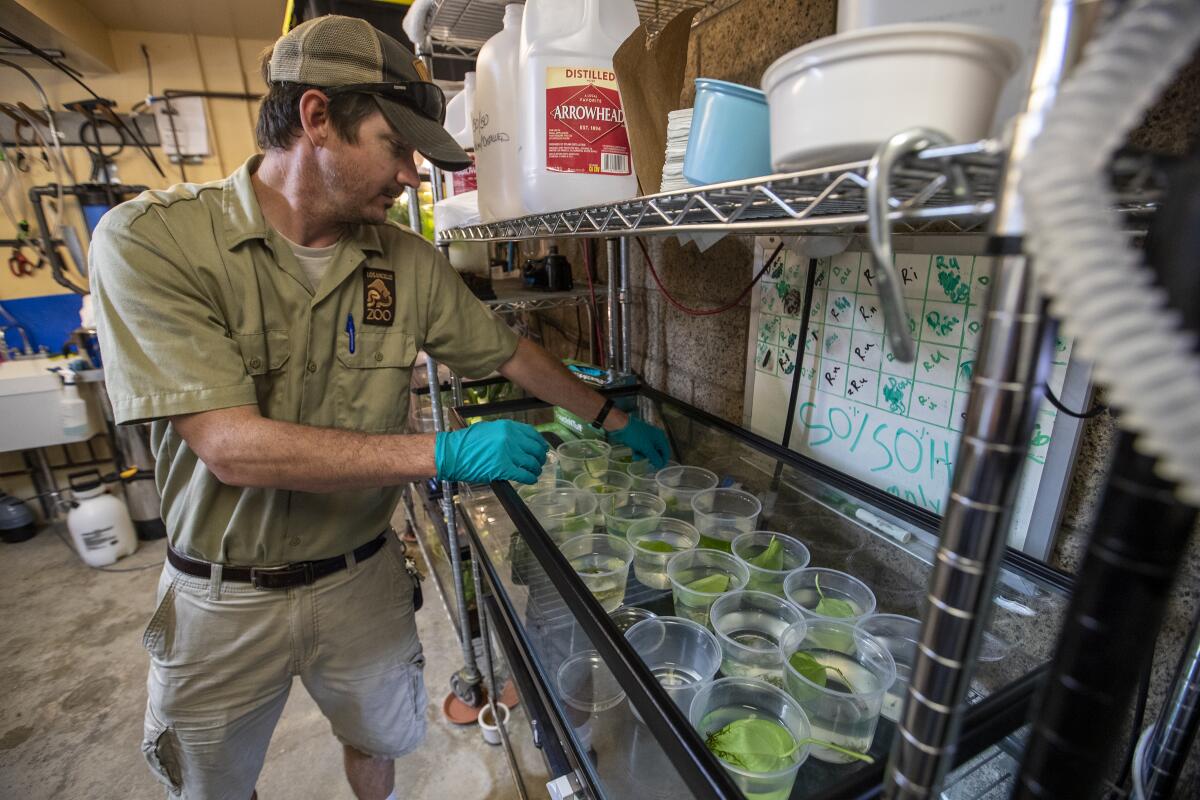Meet the ‘rock star’ frog breeder vying to save Southern California’s rarest amphibian

- Share via
It was happy hour at the “Frog Shack,” a tiny building at the Los Angeles Zoo offering all the amenities that Southern California’s rarest — and perhaps fussiest — amphibians might need to survive.
Aeration and water filtration systems hummed softly in rows of temperature-controlled tanks, where tadpoles of the southern mountain yellow-legged frog binged on a mix of algae flakes and vitamins. Fist-sized adult frogs, some of them bulging with eggs, lounged on pebble beds after a meal of crickets and wax worms.
This is where Ian Recchio, the zoo’s curator of reptiles and amphibians, is performing what some call miracle work in keeping alive a federally endangered species, one of the rarest vertebrates on Earth. Recchio might be unknown to the general public, but in the effort to save and recover these frogs, Recchio is, as U.S. Geological Survey biologist Robert Fisher put it, “a rock star.”
“He’s a no-nonsense, reliable guy who knows what he’s doing and gets the job done,” said Fisher, who notes that southern mountain yellow-legged frogs are notoriously hard to breed in captivity and harder still to reintroduce into their native habitat — the high-elevation streams of the San Bernardino, San Gabriel and San Jacinto mountains.
“The success rate of reintroduced tadpoles and frogs … has not been great,” Fisher added. “But it has kept this species from blinking out of existence.”
Recchio is more humble about what the Frog Shack is accomplishing. “As long as yellow-legged frogs are needed, I can produce them,” he said.
Named for the bright yellow on their undersides, southern mountain yellow-legged frogs once thrived in hundreds of streams cascading down the high mountains that surround Los Angeles.
But since the 1960s, nonnative trout, bullfrogs and crayfish have decimated these frogs. So have wildfires, extreme weather and hotter stream temperatures linked to climate change. With skin as permeable as a sponge, the frog is also highly susceptible to a skin fungus linked to amphibians vanishing around the world.
By 2002, when the species was listed under the federal Endangered Species Act, fewer than 100 adults remained in the region. The situation demanded an emergency intervention, and Recchio is one expert who answered the call.
Clad in blue jeans, a baseball cap and scuffed leather shoes, Recchio, 48, moved quietly through the Frog Shack on a recent weekday to avoid rousing its sensitive inhabitants. He surveyed the scene in the 15-by-15-foot captive breeding facility like a satisfied impresario.

“Everything that happens here aims to mimic the conditions of the frog’s natural life cycles of winter hibernation, spring thaw and mating season,” he said. “And this year, we hatched out more than 1,000 new tadpoles for the federal effort to recover one of the rarest amphibians on the planet.”
Part of Recchio’s success has come through trial and error — learning from past setbacks to breed yellow-legged frogs. In 2011, for example, a Fresno Chaffee Zoo effort was tripped up by the deaths of 104 frogs that, two years earlier, had been rescued from the fire-stripped San Gabriel Mountains.
A breakthrough came when Recchio and other scientists learned that the life cycle of yellow-legged frogs from the San Gabriel Mountains was different from that of their cousins in the San Bernardino and San Jacinto mountains. For one thing, the San Gabriel tadpoles metamorphose about twice as fast as those in nearby mountain ranges.
“Our San Gabriel Mountain tadpoles become frogs within about a year — and that was a little bit of an issue,” Recchio said, “because our initial captive breeding protocol was based, in part, on one developed at the San Diego Zoo, which deals with frogs from the San Bernardino and San Jacinto mountains.”
Recchio and his team had to develop a new template. He developed one from a program used to successfully breed Armenian vipers, a venomous snake found in alpine terrain with steep annual temperature changes and light gradients.
The scientists started adjusting conditions in the lab to replicate the frogs’ winter cycle, which begins in mid-October.
“That’s when we start stepping down the amount of light in the room by about an hour each week,” said zookeeper Marlowe Robertson-Billet, 37, who monitors the amphibians with the attention of a full-time nanny, “and chilling the water temperature in their tanks by 1 to 2 degrees once or twice a week.”
Those conditions mimic what the wild frogs experience in the dead of winter, when they hunker down in a mud bank under a blanket of snow.
“So, by mid-December,” she said, “the facility is in total darkness, the water is chilled to 34 degrees and the frogs are in a state of hibernation, absorbing oxygen through their skin and floating to the surface every hour or so for a gulp of air.”
In April, the cycle is reversed. By mid-August, she said, the water has reached its peak temperature of 60 degrees.

The bounty of the team’s work is hundreds of new tadpoles each year. About 900 of this year’s crop were released Wednesday in a creek where they’d been absent for half a century. A year ago, about 500 tadpoles were released into a stream elsewhere in the range.
They are the offspring of two genetically distinct groups of tadpoles Recchio took into his care in 2014 as what he described as a “genetic insurance colony” to prevent the species from spiraling into oblivion. This marks the second year tadpoles raised at the zoo have been released into the Angeles National Forest.
Recchio grew up in the San Gabriel Valley, and his fascination with things that crawl, croak and slither began when he was a kid, accompanying his father, an amateur herpetologist, on collecting trips across the American West and Mexico.
He absorbed books about herpetology and about naturalists, such as Laurence M. Klauber, the first curator of reptiles and amphibians at the San Diego Natural History Museum.
As a teenager, he started volunteering at the Los Angeles Zoo, where he befriended curators and zookeepers, and went on to assist in studying and collecting reptile and amphibian specimens from around the world.
A personal highlight came in the early 1990s, when Recchio found a rosy boa — one of only two boa snakes native to the United States — in the shadows of the Hollywood sign.
“It remains the only one ever recorded at that cultural icon,” said Recchio, who has served as the Los Angeles Zoo’s curator of herpetology for 13 years and helped design its Living Amphibians, Reptiles and Invertebrates facility. He is also a member of the Assn. of Zoos and Aquariums’ Komodo dragon committee and an expert on pit vipers.
The federal frog recovery program he is part of goes beyond captive breeding. Since 2006, federal wildlife authorities have worked to remove nonnative trout from some of the frogs’ ancestral haunts and, in certain areas, they have barred public access.
The collaborative effort includes the Los Angeles Zoo, the San Diego Institute for Conservation Research, the Henry Doorly Zoo and Aquarium in Omaha, the U.S. Forest Service, the U.S. Fish and Wildlife Service, the U.S. Geological Survey and the California Department of Fish and Wildlife.
So far, however, tadpoles and frogs raised at the Los Angeles and San Diego zoos haven’t spurred an exponential resurgence in wild southern mountain yellow-legged frogs. Today, fewer than 400 of them are believed to exist in the wild.
“These little guys will face an uphill battle after they’re reintroduced … no doubt about it,” Recchio said. “It’s getting hard to find habitat that isn’t a flood zone or drought-stricken or dominated by invasive predators like trout and bullfrogs.”
Amphibians produce huge numbers of eggs, and one reason is that only the luckiest and hardiest survive. For the same reasons, it has been difficult for biologists to keep track of captive-bred frogs and tadpoles after they are released into their native habitat.
The San Diego Zoo has launched an experiment to resolve that problem: Biologists have surgically implanted microchip radio transmitters, the size of rice grains, into 25 captive-bred yellow-legged frogs scheduled for release in September in the San Jacinto Mountains.
“The goal is to chart the progress of reintroduced frogs with real-time data on their movements and locations,” said Talisin Hammond, a biologist at the San Diego Zoo Institute for Conservation Research. “The results could be critical to the ultimate survival of this unique species.”
Recchio would not argue with any of that. “When it comes to saving endangered amphibians here and around the world,” he said, “this is a time of experimentation.”








